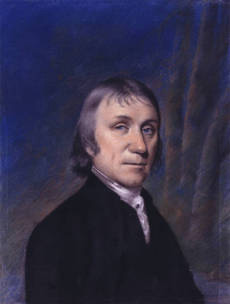HISTORY OF CHEMISTRY: Dr Joseph Priestley (1733-1804)
Foremost in the number of those who after Black distinguished themselves as pneumatic chemists, was Dr. J. Priestley (1733-1804).
His first discovery, made in 1772, was nitric oxide gas, which he soon employed in the analysis of air.
Boyle, more than a century before Priestley began his experiments, had stated in The Sceptical Chemist, that "without the addition of any extraneous body, quicksilver may by fire alone, and that in glass vessels, be deprived of its silver-like colour, and be turned into a red body; from this red body, without addition, likewise may be obtained a mercury bright and specular as it was before." -- (Boyle’s Works, ed. Birch, p. 352, Lond. 1744.)
On the 1st of August, 1774. Priestley discovered that the red oxide of mercury evolved a gas when heated. This gas (oxygen) being superior even to the air as a supporter of combustion was regarded by him as dephlogisticated air; the incombustible part of the atmosphere he supposed to be saturated with phlogiston, on the assumption that a gas was so much the better adapted for supporting combustion as it contained within itself a smaller quantity of that body. Common air, by drawing phlogiston from burning substances, became as he thought, phlogisticated air, and on that account had no longer any attraction for phlogiston, or, in other words, any power of supporting combustion. The phlogiston evolved in the burning of combustibles and in the calcinations of metals was supported to unite with the atmosphere or the dephlogisticated air contained therein, and that which was produced by the action on the atmosphere of the phlogiston lost by the metals was the cause of the increased weight of their calces. The opinion that the air given off during the solution of metals in acid was their combustible constituent had been advanced in 1700 by Lémery; and Priestley, guided apparently by the notion suggested by Cavendish’s experiments, that to unite the acids metals must part with their phlogiston, considered inflammable air (hydrogen) either as identical with or at least very rich in that principle.
In 1788, in order to explain the formation of water from a mixture of inflammable and dephlogisticated air, he put forward the hypothesis that water entered into the composition of these and of fixed and other airs; inflammable air, he thought, might be the principle of alkalinity, dephlogisticated air, as Lavoisier ahd shown, being the principle of acidity.
To the last Priestley was an advocate of the phlogistic philosophy, and though unquestionably one of the fathers of modern chemistry was always, to quote the words of Cuvier, "un père qui ne voulut jamais reconnoiter sa fille."
Besides nitric oxide and nitrogen, Priestley first made known sulphurous acid gas, gaseous ammonia and hydrochloric acid, and carbon monoxide; and he it was who, by showing that the condition of ammoniacal gas and of common air is altered by the transmission of electric sparks, led to Berthollet’s analysis of ammonia, and Cavendish’s discovery of the composition of nitric acid.
Related Page: Biography of Joseph Priestley
Read the rest of this article:
Chemistry - Table of Contents
